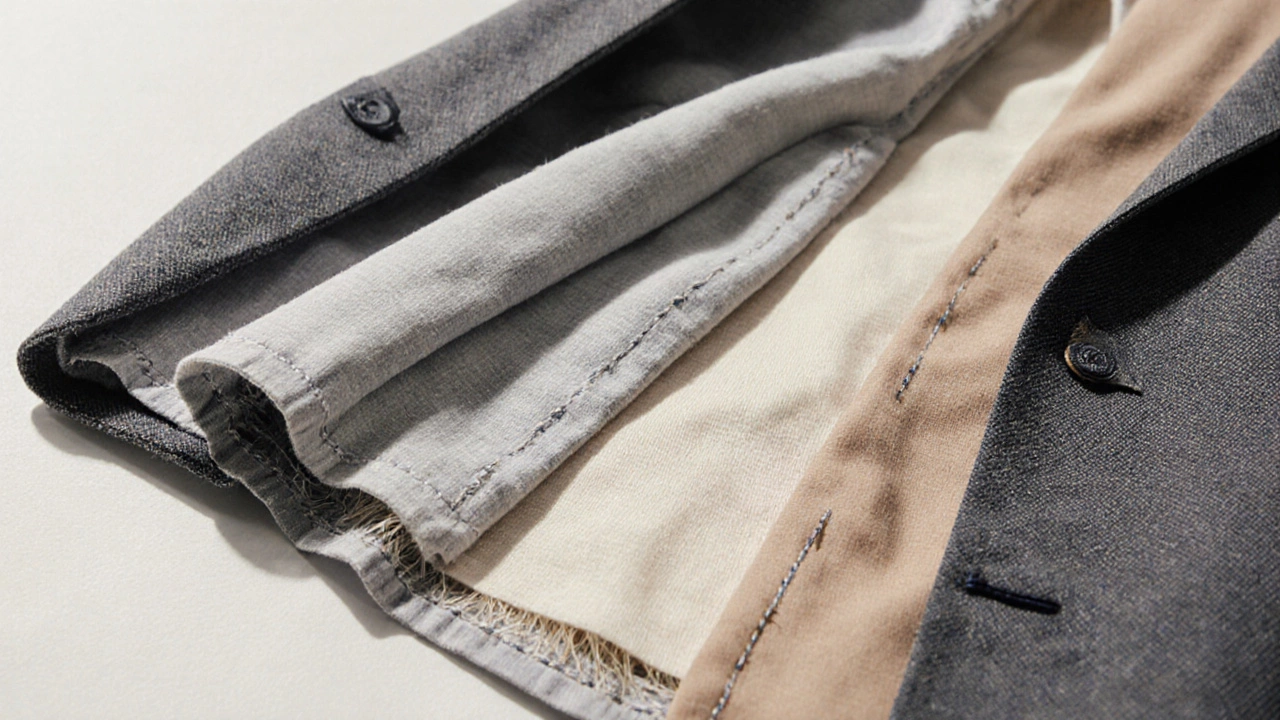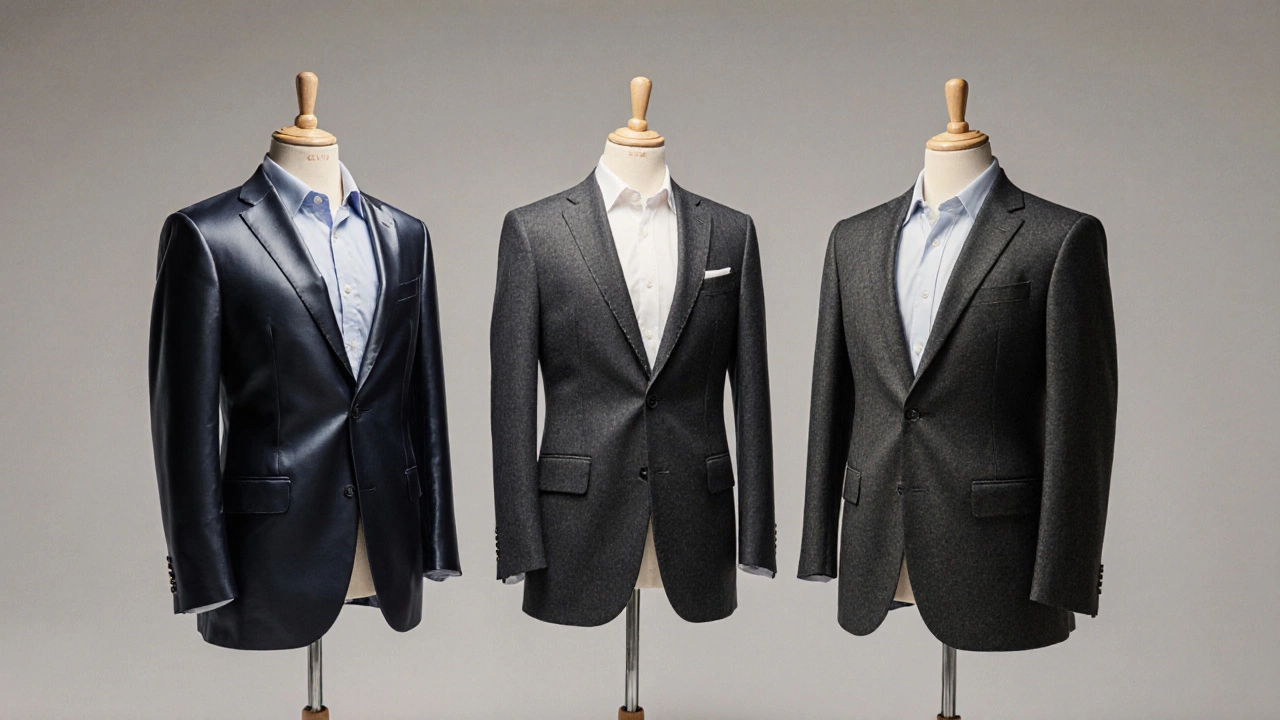Cheap Suit Buyer's Guide
Cheap Suit (£100-£250)
Off-the-rack, mass-produced with basic fabrics
Polyester Blend Low-grade WoolMid-range (£250-£600)
Better fabrics, some hand-finishing
Wool Blend Better ConstructionPremium (£600+)
Designer labels, high-grade wools
Pure Wool Canvassed ConstructionFabric Comparison
- Polyester Blend Low Cost
- Viscose/Rayon Moderate Cost
- Low-grade Wool Moderate-High Cost
- Pure Wool High Cost
Construction Features
- Machine-stitched seams Cheap
- Basic lining Standard
- Minimal shoulder padding Budget
- Ready-to-wear fit Generic
Key Takeaway
A cheap suit offers affordability but may compromise on durability, fit, and comfort. It's ideal for occasional use or one-time events where you don't want to invest heavily.
Where to Shop
- High-street chains (Mark & Spencer, H&M)
- Online fast-fashion (ASOS, Zara)
- Outlet stores and discount malls
- Second-hand apps (Depop, Vinted)
Pros & Cons
Pros
- Low upfront cost
- Wide style selection
- Easily replaceable
Cons
- Shorter lifespan
- Limited fit
- Less breathable
Quick Summary / Key Takeaways
- A cheap suit typically costs under £250 in the UK market.
- Common low‑cost fabrics are polyester blends, viscose, and low‑grade wool.
- Construction is simpler: fewer hand‑stitched seams, basic linings, and minimal tailoring.
- Best places to buy include high‑street chains, online fast‑fashion sites, and outlet stores.
- Weigh the trade‑offs: affordability versus durability and fit.
When hunting for a cheap suit is a budget‑friendly outfit that usually costs under £250, built with cost‑effective fabrics and simple construction, it helps to know what price, material and fit really mean. Whether you need a suit for a job interview, a wedding guest slot, or just a smart‑casual look, understanding the components that drive cost will prevent nasty surprises later.
Understanding a Cheap Suit
A suit is a matching jacket and trousers ensemble traditionally worn for formal or business occasions. When the price tag stays low, several compromises usually appear: the fabric is less premium, the stitching is machine‑sewn rather than hand‑stitched, and the fit is more generic. These shortcuts keep the price down but also affect how the suit drapes, how long it lasts, and how easy it is to alter.
Price Benchmarks in 2025
In 2025 the UK market shows clear buckets:
- Cheap: £100-£250 - off‑the‑rack, mass‑produced, basic fabrics.
- Mid‑range: £250-£600 - better fabrics, some hand‑finishing, more tailored cuts.
- Premium: £600+ - designer labels, high‑grade wools, fully canvassed construction.
The price is a numeric value that reflects material cost, labor, brand positioning and retailer markup. For a cheap suit, the bulk of that amount goes to the retailer’s margin rather than fabric quality.
Fabric & Materials That Keep Costs Low
The choice of fabric is a textile used to construct the jacket and trousers, influencing feel, drape and durability. Budget suits most often rely on:
- Polyester blends - cheap, wrinkle‑resistant, but can feel plasticky.
- Viscose or rayon - adds a smoother hand but reduces breathability.
- Low‑grade wool (often 50% wool, 50% synthetic) - gives a traditional look without the price of pure wool.
These fabrics are usually woven in high‑volume factories overseas, which drives the cost down to around £10‑£15 per meter, compared with £30‑£45 per meter for a premium worsted wool.
Construction & Fit: Where Savings Show Up
Construction refers to how the pieces of a suit are assembled. In a cheap suit you’ll often find:
- Fully machine‑stitched seams - faster but less durable than hand‑stitched.
- Basic lining made from viscose or polyester - cheap, but can feel hot in summer.
- Minimal shoulder padding and a simple lapel shape - reduces material waste.
- Ready‑to‑wear fit is a standard, non‑customized sizing based on generic body measurements - you may need a tailor to adjust sleeves or waist.
Because the internal canvas (the fabric that gives structure to the jacket) is often omitted, cheap suits may feel floppy after a few wears. The lack of detailed tailoring is a the process of adjusting a garment to improve its fit and appearance also means alterations can be more expensive proportionally.

Where to Find Affordable Suits
Several retailers specialize in budget suits:
- High‑street chains like Mark&Spencer and H&M - offer suits from £120‑£200, often with seasonal sales.
- Online fast‑fashion platforms (e.g., ASOS, Zara) - provide a wide range of styles, free returns make trying easier.
- Outlet malls and discount department stores - previous season stock at 30‑50% off.
- Second‑hand apps (e.g., Depop, Vinted) - you can snag a higher‑quality suit for cheap if you’re okay with minor wear.
When shopping, look for clear return policies and check the fabric composition label. A 50/50 wool‑polyester blend should be explicitly listed.
Pros and Cons of Buying a Cheap Suit
Every purchase has trade‑offs. Here’s a quick rundown:
- Pros
- Low upfront cost - great for one‑off events.
- Wide style selection - trends change fast in fast‑fashion lines.
- Easy to replace - you won’t lose much if it gets stained.
- Cons
- Shorter lifespan - seams may open after a few washes.
- Limited fit - may require costly tailoring.
- Less breathable - synthetic fabrics trap heat.
Side‑by‑Side Comparison
| Aspect | Cheap (<£250) | Mid‑Range (£250‑£600) | Premium (£600+) |
|---|---|---|---|
| Fabric | Polyester blend, low‑grade wool | 70% wool, 30% polyester or cotton | 100% Super 120s wool or cashmere |
| Construction | Fully machine‑stitched, no canvas | Half‑canvas, some hand‑stitched lapels | Full‑canvas, hand‑stitched throughout |
| Fit | Standard ready‑to‑wear | Trim fit, easier to alter | Custom or made‑to‑measure |
| Lining | Polyester viscose | Polyester‑rayon blend | Silk or high‑quality Bemberg |
| Durability | 2‑3 years with light use | 4‑6 years | 10+ years with proper care |
| Typical Price (UK) | £120‑£250 | £260‑£590 | £610‑£2000+ |
How to Get the Most Value from a Cheap Suit
- Check the fabric label - aim for at least 50% wool for better drape.
- Buy one size up if you plan to have it altered; a small waist can be taken in more easily than a small chest.
- Invest in a good dry‑cleaner; cheap suits are more sensitive to harsh chemicals.
- Store it on a wide hanger with a breathable garment bag to avoid crushing the shoulders.
- Consider a simple upgrade: replace the lining yourself or add a subtle pocket square for a smarter look.
Frequently Asked Questions
What price range defines a cheap suit in the UK?
A cheap suit typically costs between £100 and £250, covering off‑the‑rack options from high‑street retailers.
Are polyester blends acceptable for a formal event?
Polyester blends can look decent if the cut is good and you pair them with a crisp shirt and tie. However, they lack the breathability and drape of wool, so they’re best for short‑term events.
Can I alter a cheap suit without breaking the bank?
Yes. Simple alterations like taking in the waist or shortening sleeves usually cost £30‑£60 in most UK tailors. More complex changes (e.g., adding a full canvas) can become uneconomical.
How often should I dry‑clean a cheap suit?
Aim for no more than 3‑4 cleanings per year. Spot‑clean stains and air it out after each wear to extend the fabric’s life.
Is buying a second‑hand cheap suit a good idea?
Often true. You can find a higher‑grade wool suit for the price of a new cheap one on platforms like Depop, provided you inspect the condition and check for any repairs needed.
Next Steps
If you’ve decided a cheap suit fits your immediate needs, start by browsing the latest collections on the retailer websites mentioned above. Note the fabric percentages, compare the cut (slim vs classic), and read recent customer reviews for insights on durability. Once you have a candidate, order the size you usually wear, try it on at home, and plan any needed alterations within a week of receipt. Follow the care tips to keep it looking sharp, and you’ll have a reliable, wallet‑friendly suit ready for any occasion.

